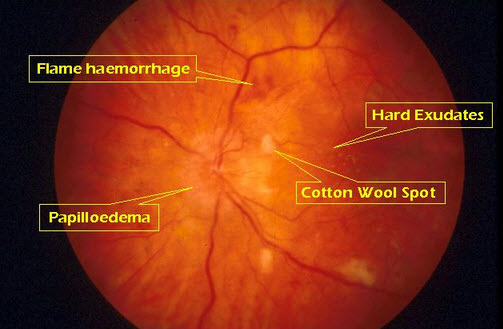Congenital PTOSIS

The retina is the tissue layer located in the back of your eye. This layer transforms light into nerve signals that are then sent to the brain for interpretation. When your blood pressure is too high, the retina’s blood vessel walls may thicken. This may cause your blood vessels to become narrow, which then restricts blood from reaching the retina. In some cases, the retina becomes swollen.
Over time, high blood pressure can cause damage to the retina’s blood vessels, limit the retina’s function, and put pressure on the optic nerve, causing vision problems. This condition is called hypertensive retinopathy (HR).
What Causes Hypertensive Retinopathy?
Prolonged high blood pressure, or hypertension, is the main cause of HR. High blood pressure is a chronic problem in which the force of the blood against your arteries is too high. The force is a result of the blood pumping out of the heart and into the arteries as well as the force created as the heart rests between heartbeats. When the blood moves through the body at a higher pressure, the tissue that makes up the arteries will begin to stretch and will eventually become damaged. This leads to many problems over time.
HR generally occurs after your blood pressure has been consistently high over a prolonged period. Your blood pressure levels can be affected by:
- a lack of physical activity
- being overweight
- eating too much salt
- a stressful lifestyle
High blood pressure also runs in families.
How Is Hypertensive Retinopathy Diagnosed?
Ophthalmoscope
We use a tool called an ophthalmoscope to examine your retina. This tool shines a light through your pupil to examine the back of your eye for signs of narrowing blood vessels or to see if any fluid is leaking from your blood vessels. This procedure is painless. It takes less than 10 minutes to complete.
Fluorescein Angiography
In some cases, a special test called fluorescein angiography is performed to examine retinal blood flow. In this procedure, the doctor will apply special eye drops to dilate your pupils and then take pictures of your eye. After the first round of pictures, your doctor will inject a dye called fluorescein into a vein. They’ll typically do this on the inside of the elbow. They’ll then take further pictures as the dye moves into the blood vessels of your eye.
Classification of Hypertensive Retinopathy
The extent and severity of the retinopathy is generally represented on a scale of 1 to 4. The scale is called the Keith–Wagener–Barker Classification System. The four grades increase in severity:
- In Grade 1, there’s a mild narrowing of the retinal artery.
- Grade 2 is similar to grade 1, but there’s more severe or tighter constrictions of the retinal artery. This is called arteriovenous, or AV, nipping.
- Grade 3 has the signs of grade 2, but there’s also retinal edema, microaneurysms, cotton-wool spots (fluffy white lesions on the retina), and retinal hemorrhages (bleeding).
- Grade 4 has severe signs of grade 3 along with optic disc swelling called papilledema and macular edema. People with grade 4 retinopathy have a higher risk for stroke and may have kidney or heart disease.
On the lower end of the scale, you may not have any symptoms. At grade 4, however, your optic nerve may begin to swell and cause more serious vision problems. High-grade retinopathy tends to indicate serious blood pressure concerns.
Complications of Hypertensive Retinopathy
People with HR are at risk of developing complications related to the retina. These include the following:
Ischemic optic neuropathy occurs when high blood pressure blocks off normal blood flow in the eyes, damaging the optic nerve. The optic nerve carries images of what we see to the brain.
Retinal artery occlusion occurs when the arteries that carry blood to the retina become blocked by blood clots. When this happens, the retina doesn’t get enough oxygen or blood. This results in vision loss.
Retinal vein occlusion occurs when the veins that carry blood away from the retina become blocked by blood clots.
Nerve fiber layer ischemia or damage to the nerve fibers may lead to cotton-wool spots, which are fluffy white lesions on the retina.
Malignant hypertension is a rare condition that causes blood pressure to increase suddenly, interfering with vision and causing sudden vision loss. This is a potentially life-threatening condition.
People with HR are also at an increased risk of having a stroke or heart attack. One study found that people with HR were more likely to suffer from a stroke than people without the condition. This was true even in people with blood pressure controlled by treatment. Another study showed both an increased risk of stroke or cardiovascular disease in people with HR.
Treatment for Hypertensive Retinopathy
Effective treatment for HR involves controlling and lowering high blood pressure with a combination of medications and lifestyle changes.
Lifestyle Changes
A diet high in fruits and vegetables may help lower blood pressure. Regular physical activity, reducing salt intake, and limiting the amount of caffeine and alcoholic beverages you drink all contribute to healthy blood pressure as well. If you smoke, take steps to quit. If you’re overweight, losing weight is an effective strategy for controlling high blood pressure.
Medications
Your doctor may prescribe blood pressure medications such as diuretics, beta blockers, or ACE inhibitors.
You can control this condition by controlling your blood pressure. If your condition is severe, however, you may have irreversible eye damage that causes permanent vision problems.
Tips to Prevent Hypertensive Retinopathy
To prevent HR, take steps to avoid high blood pressure:
- - Take your blood pressure medication regularly.
- - Get regular exercise.
- - Eat a balanced diet.
- - Avoid smoking.
- - Get regular medical exams to ensure that your blood pressure readings are normal.

